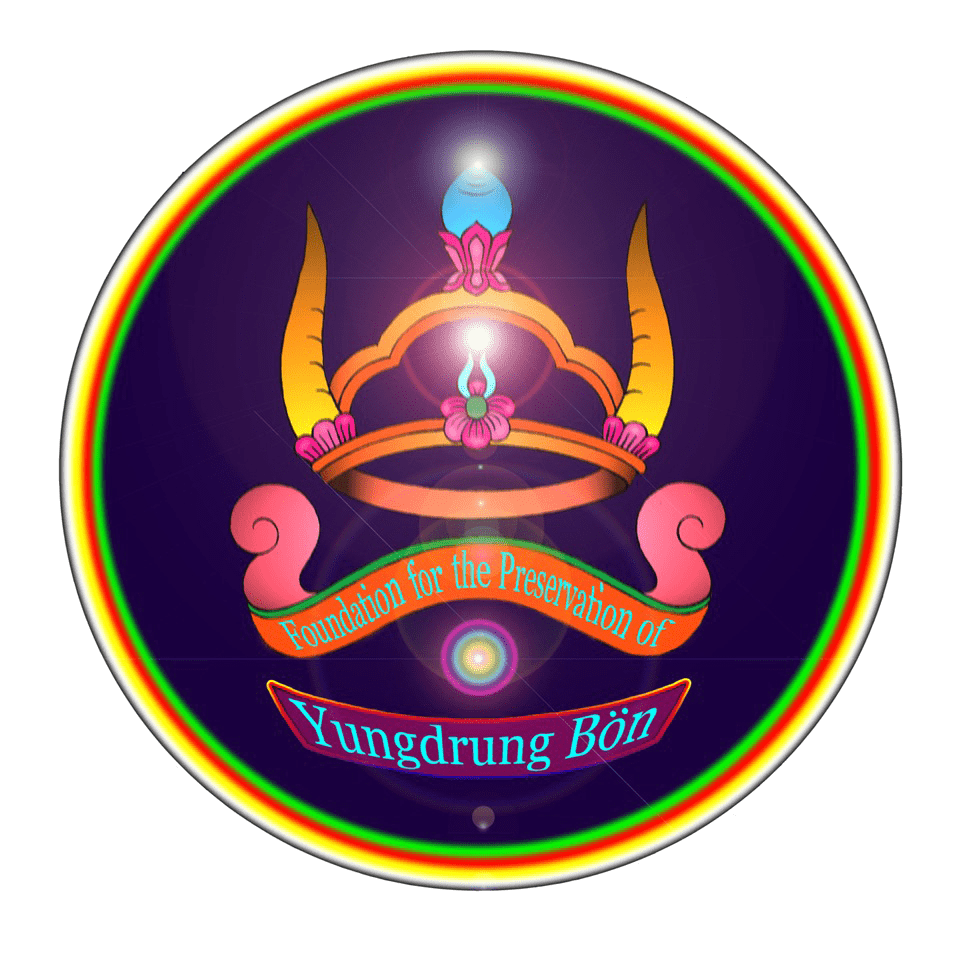Three Drenpa Namkhas in Yungdrung Bön
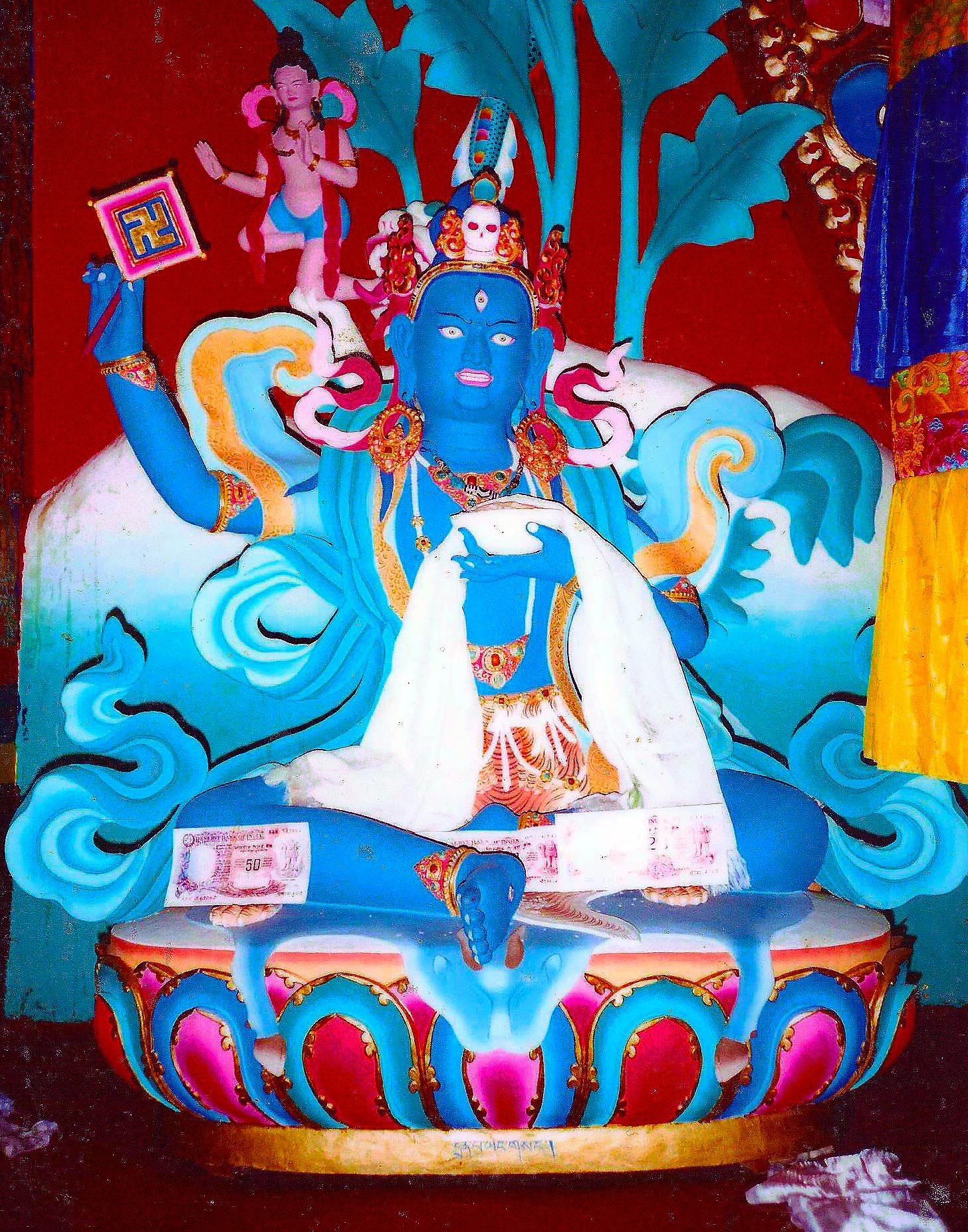
by Dmitry Ermakov
In this article, we will take a brief excursion into the story of Drenpa Namkha,[1] one of the most famous and powerful masters in Yungdrung Bön. According to Yungdrung Bön sources, there were three major emanations of Drenpa Namkha throughout history, and all were great yogis[2] and scholars. The later two, Drenpa Namkha of Zhang Zhung and Tibetan Drenpa Namkha, are both renowned for preserving the Yungdrung Bön teachings in times of persecution and bear the title The Defender (of the Teachings) in the Degenerate Age.[3]
The first Drenpa Namkha: Drenpa Namkha of Tagzig
The first Drenpa Namkha’s life is shrouded in the mists of time. It is said that a syllable A emanated from the bönku[4]– Body of the Ultimate Nature of Phenomena – of Tönpa Sherab[5] and descended onto a blue flower with thousandfold petals in Tagzig.[6] The A transformed into the first Drenpa Namkha, who took the blue colour of the lotus. At that time, his name was Dagpa Drime[7] – Stainless Purity. His purpose was to preach Yungdrung Bön doctrines because the time and place were suitable. Little is known about this Drenpa Namkha, except that, at the time of his realisation, he transformed into a ball of rainbow light, which disappeared into the sky through the rock ceiling of his cave, leaving a passageway through it.
Subsequently, several reincarnations appeared through the ages under different names throughout Central Asia and the Tibetan Plateau.
One of these reincarnations, called Dzuthrul Yeshe,[8] Miraculous Emanation of Wisdom, appeared in Wolmo Lungring, the sacred inner region of Tagzig in Central Asia.[9] He manifested as a drangsong,[10]a fully ordained Bönpo monk, and it was he who brought the Bönpo monastic system[11] to Zhang Zhung.[12] He prophesised that he would be reborn as a prince of Zhang Zhung in the future.
The second Drenpa Namkha: Drenpa Namkha of Zhang Zhung
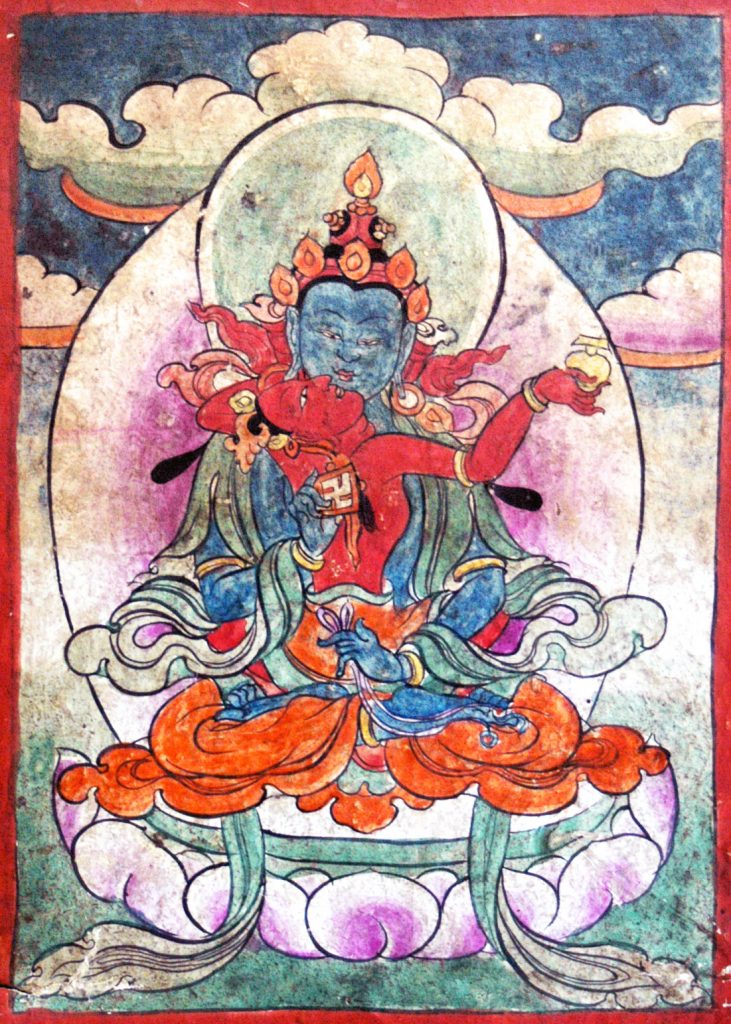
The second Drenpa Namkha, Khöpung Drenpa Namkha,[13] was one of the most prominent shenpo,[14]orYungdrung Bön masters,of Zhang Zhung. According to traditional Bönpo chronology, [15] he was born in 914 BC as a prince into the imperial dynasty of Zhang Zhung in the capital, Khyunglung Ngulkhar,[16] the Silver Castle of the Khyung Valley, which was located to the West of Mt. Tise (Kailash). His father was called Gyungyer Mukhö[17] and his mother was called Chyatsün Gungma.[18] As a boy, Khöpung Drenpa Namkha had many Bönpo teachers and studied and practised Yungdrung Bön. He later renounced his princedom and went to practise in the wilderness, meeting and receiving teachings and instructions from many siddhas of India, Zhang Zhung, Tagzig, Drusha and Thokar,[19] and eventually becoming a great yogi.
One day, a khandro[20] appeared to him, saying he must go to India and find his khandro-consort in order to ensure the continuation of his lineage and the spread of his doctrines in various countries. Drenpa Namkha followed this prophecy and went to India, where he visited many holy places, including the Eight Great Charnel Grounds.[21] He spent time with several khandro there, finally meeting a young woman from the brahmin caste of Oddiyana[22] called Wöden Barma,[23] Radiant Woman of Brahmin Caste. Despite the cultural taboos of the time, she became his consort, and together they returned to Zhang Zhung, where, in 888 BC,[24] their twin sons were born.
Khöpung Drenpa Namkha held a great number of lineages and spread the teachings far and wide, including in Tibet. Many of his teachings, particularly Tantra[25] and Dzogchen,[26] are still used by Bönpos today. Thanks to the power of his practice, he obtained an extraordinary lifespan and also figures as a contemporary of the eighth Tibetan king, Drigum Tsenpo,[27] who lived in the seventh century BC.[28] This period became known as the first persecution of Yungdrung Bön, and Drenpa Namkha is accredited with saving religious texts – and indeed the Yungdrung Bön tradition in general – from the destruction unleashed by Drigum Tsenpo. At the end of his life, Khöpung Drenpa Namkha manifested the Rainbow Body of Great Transfer.[29]
Twin brothers
Drenpa Namkha’s two sons were named Tsewang Rigdzin,[30] Knowledge-holder with Long-life Power, and Pema Töngdrol,[31] Lotus of Liberation Through Seeing. Tsewang Rigdzin was the firstborn of the twins. According to Tsewang Nyengyud [32] and Rigdzin Dhüpa.[33] Pema Thöngdrol, the second twin, became Guru Padmasambhava in a later incarnation.
The twins’ father, Khöpung Drenpa Namkha, was a very learned man, as well as a great practitioner. Their mother had received many teachings and initiations, too, so naturally she was also an accomplished practitioner. One day, she saw through her clairvoyance that a brahmin who had led a perfect religious life for seven consecutive lifetimes[34] had passed away. Since the corpse of such a person is used in some Tantric rites to obtain certain psychic powers, Wöden Barma knew that if she could obtain the body, her knowledge and power would develop such that she could become a wisdom khandro.[35] Obtaining the corpse was no easy matter, however, because many beings wanted even a little piece as a relic. So Wöden Barma asked her husband to subdue all the obstructing spirits so that she could get the whole corpse of this brahmin. Understanding how much it meant to his wife, Drenpa Namkha promised to use his tantric powers to help her. Leaving the two boys with their father, Wöden Barma set out. In the meantime, however, Drenpa Namkha became a little agitated and so he did not concentrate fully. As a result, his wife was only able to get a single hair of the brahmin.
Wöden Barma was very upset, and when she returned home, she chided Drenpa Namkha saying: ‘We’ve been together a long time, we have these two boys together. It was very important for me to get this corpse, but you got distracted. So now I want to separate from you. I don’t want to stay here. I’m going back to India’. Drenpa Namkha apologised, but she was adamant, wanting to take both sons and her assistant along with her. Drenpa Namkha agreed, but the twins decided it would be better if Tsewang Rigdzin, the older twin, stayed with their father, while Pema Thöngdrol went with his mother. Despite their mother’s pleadings, Tsewang Rigdzin stayed with his father in Zhang Zhung, but to please her, he promised not to mingle with the local people and instead to stay in retreat practising and receiving teachings from his father.
Wöden Barma took her son Pema Thöngdrol to her native land, Oddiyana, which bordered Zhang Zhung to the southwest and is generally thought to be the modern-day Swat Valley in Pakistan. While travelling through Oddiyana, Wöden Barma’s clairvoyance revealed that there was another brahmin corpse suitable for her practice some distance away. Setting her son Pema Thöngdrol down on one of the gigantic lotuses which were floating in the shallow waters near the shore of Lake Danakosha,[36] she set off to fetch the brahmin’s corpse. However, it took her longer than she had expected, and by the time she got back to the lake, the sun had already set, the lotus flowers had closed their petals for the night and she was unable to find her son sleeping inside one of them. Distraught, she began tearing off the stalks of several plants, looking desperately for her son. The current carried one of these flowers to the far shore of the lake, and at sunrise, it opened up to reveal Pema Thöngdrol sitting in the centre, to the great surprise of King Indrabodhi, who was walking nearby with his wife. This happened in 876 BC[37] when Pema Thöngdrol was twelve years old, and that is the beginning of his story as the Lotus-Born Padmasambhava, as he known to Tibetan Buddhists.
When the King and Queen saw the boy, they remembered an earlier prophecy foretelling the appearance of a miraculous child who would become a very great and powerful prince. Since the royal couple was childless, they adopted the boy as their son and prince. As the boy grew up, however, he wanted to leave the palace to continue his spiritual practice. One day, he climbed up to sit on the palace roof. Children were playing down below. Pema Thöngdrol threw a pebble at one of the boys and, due to their previous karmic connection, the pebble hit him on the head and killed him. Although this appears to be a crime, Pema Thöngdrol, who already possessed great spiritual powers, in fact liberated the boy from his negative karma. However, this was not readily apparent to others. The dead boy was the son of a government minister, and his distraught parents demanded that Pema Thöngdrol be punished in accordance with the laws of the land. They stirred up the townsfolk and soon the palace was surrounded by crowds calling for the law to be applied equally to everyone. The King summoned the council, and it was decided that, in order to avoid a revolution, Pema Thöngdrol should be executed; such was the lawful punishment for murderers. Although deeply distressed, the King and Queen had to comply. To soften the blow, the Queen was allowed to choose the method of execution. She opted for the method of drowning, thinking it would be less painful than the other alternatives of being burnt alive or killed by the bite of a poisonous snake. And so Pema Thöngdrol was thrown into a lake. Much to everyone’s surprise, however, he did not drown. Instead, he appeared sitting in meditation on a floating lotus. Denouncing this as a trick conjured by the royal guards to save the boy, the mob clamoured for justice. Pema Thöngdrol was then thrown into a place seething with poisonous snakes, but he emerged triumphant, riding one of them. Still calling for his death, the crowd demanded he should be burnt. So a huge pile of wood was gathered, Pema Thöngdrol was seated on top, and the pyre was lit. The wood blazed violently, but once it had burnt out, everyone saw Pema Thöngdrol sitting in meditation in the ashes, completely unscathed.
Soon afterwards, having obtained the brahmin corpse and fully realised her practice, Wöden Barma came to the palace. She told her son that she had now overcome all the obstacles of emotions through practice and gained siddhi, so she wanted to reunite with his father, Drenpa Namkha, in Zhang Zhung. She said that, due to the unfavourable situation in the royal household, it would be better if Pema Thöngdrol returned to Zhang Zhung with her for the time being, in order to receive more teachings and instructions from his father. The boy agreed, and together they set off to his native land. On the way, Wöden Barma pointed to a certain rock. Telling her son that an important terma[38] treasure text was concealed inside, she said he should open it one day. Thus, mother and son returned to Zhang Zhung, where they met Drenpa Namkha. Wöden Barma remained with the boys’ father, and Pema Thöngdrol stayed for a while, too, receiving teachings and instructions. When his education was completed, he went back to Oddiyana, as it was his destiny to spread the teachings there. On the way, he opened the textual treasure his mother had pointed out. It was Kabje,[39] a Tantric cycle of eight yidams. Pema Thöngdrol practised this cycle in many places in Oddiyana and attained great realisation. One of his subsequent incarnations, Guru Padmasambhava, brought this cycle into Tibet in the 8th century AD, and it is known in the Nyingma[40] School of Tibetan Buddhism as the Practice Texts of the Eight Deities.[41]
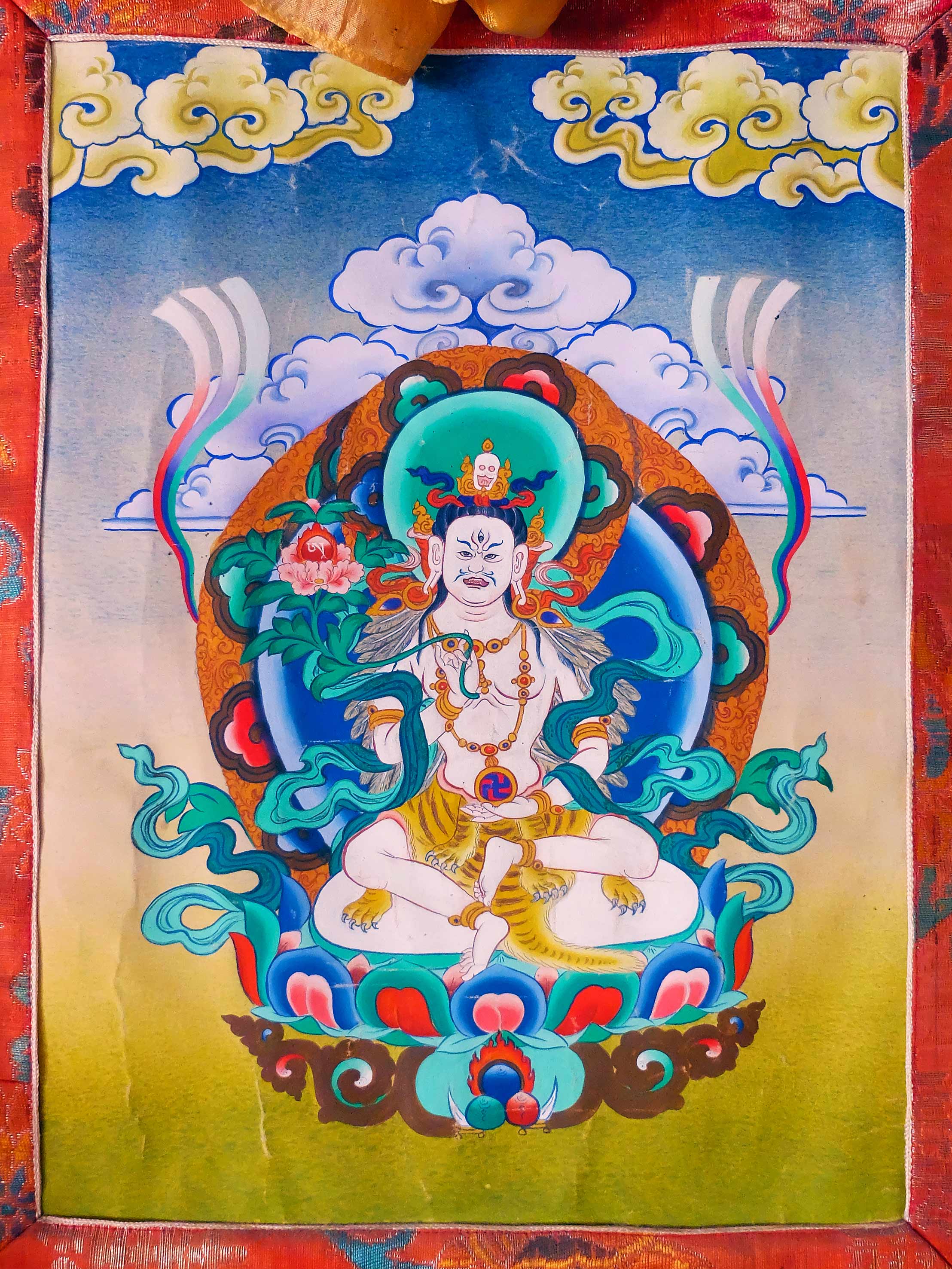
Pema Thongdrol’s twin brother, Tsewang Rigdzin, practised in many lands, such as Zhang Zhung, Tagzig, and Oddiyana as well as India, Thogar, Drusha, China,[42] Menyag[43] etc. He learned from many masters and practised with many khandro. Like his father Khöpung Drenpa Namkha before him, he attained the supreme realisation of Dzogchen, the Rainbow Body of the Great Transfer. Tsewang Rigdzin did not manifest death at all, but rather his physical body dissolved into the essence of the elements meaning that, while being a fully realised Buddha, he remains active on this level of being even now, in order to help beings by whatever means necessary.For example, he appeared several times to Lungbön Lhanyen[44] in what seemed to be a physical body and taught him the Bönpo Dzogchen cycles of Yethri Thasel[45] and Namkha Thruldzö,[46]which Tsewang Rigdzin had received earlier in the 8th century from the Tibetan Drenpa Namkha, an emanation of his father, Zhang Zhung Drenpa Namkha.
The third Drenpa Namkha: Drenpa Namkha of Tibet
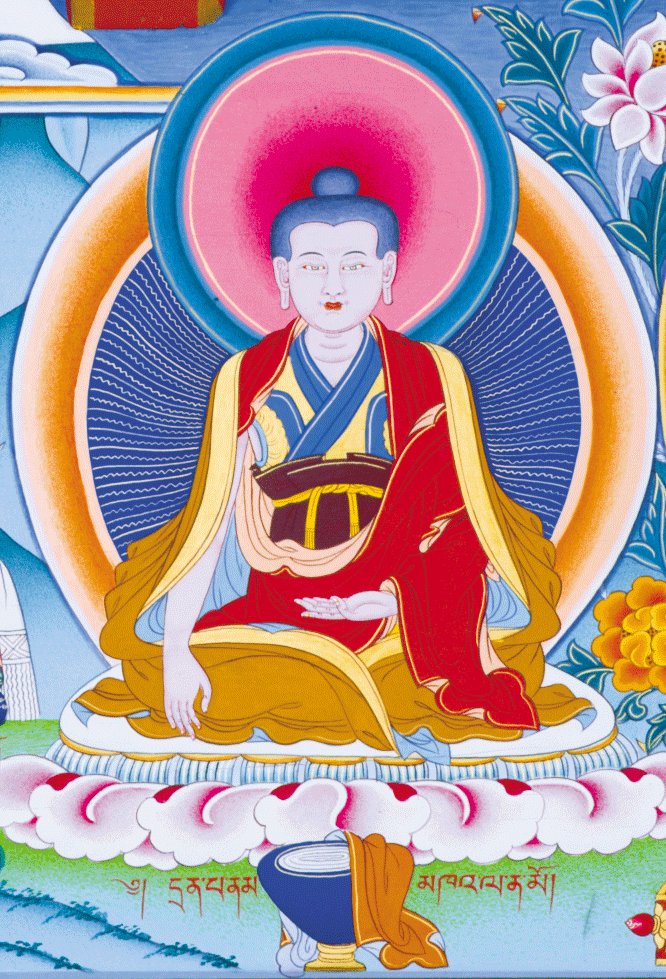
Image courtesy of International Shang Shung Institute.
The third, Gyerpung Drenpa Namkha,[47] was the sixteenth emanation after Drenpa Namkha of Zhang Zhung. This Drenpa Namkha was a Tibetan native who lived in the 8th century AD at the time when Yungdrung Bön was suffering its second persecution, this time at the hands of the Tibetan King Trisong Deutsen[48] and his Indo-Tibetan Buddhist government.
Gyerpung Drenpa Namkha was born in 702 AD,[49] the Year of the Water Tiger, in Yul Dagpo Khog[50] in southern Tibet. His father was Mushen Dagpa[51] and his mother was Dagza Khacham.[52] This third Drenpa Namkha also received a full Bönpo education, and was a great scholar and practitioner. However, these were very difficult times for Bönpos in Tibet. In his thirst for absolute power, King Trisong Deutsen decided to overturn Tibet’s triple foundation of government: King, Bön and Bönpo priests. In a bid to supplant the religion of his ancestors, he invited Buddhist scholars from India in order to remove to the authority of Bönpo masters and their religion from the political equation, thus paving the way for absolute monarchy. The new Buddhist party took control of the court and set about converting the Tibetan people to Indian Buddhism; Bönpos were forced to either convert, go into exile or face death:
“You priests, since Buddhism is good for both the here and the thereafter, I urge you to follow Buddhism and abandon Bon. You, Bon-pos, can chose whatever you like, to follow Buddhism or drink the white water[53] or accept banishment from four quarters of Tibet.”[54]
In order to save Yungdrung Bön from total annihilation, Gyerpung Drenpa Namkha struck a deal with the King; in 749 AD,[55] he temporarily converted to Indian Buddhism and became one of Guru Padmasambhava’s twenty-five main students. In exchange, he was permitted to hide a large number of Bönpo texts throughout Tibet.
After some time, bad signs such as famine, epidemics, and social unrest began manifesting all over Tibet, as newly-arrived Indian Buddhists angered local gods and protectors of Yungdrung Bön and provoked Bönpo masters. Trisong Deutsen even went as far as killing the last King Ligmincha[56] of Zhang Zhung. This prompted Ligmincha’s royal Bönpo priest, the great siddha Gyerpung Nangzher Lödpo,[57] to retaliate with a magic bomb.[58] The bomb struck King Trisong Deutsen’s quarters, causing him to fall mortally ill. Fearing for his life, King Trisong Deutsen made a deal with Nangzher Lödpo, promising not to destroy 360 kinds of Bön which the master practised and granting him and his clan special privileges at the Tibetan court in exchange for his life. The principal Bönpo protector, Machog Sipai Gyalmo,[59] also appeared to the King and ordered him to stop persecuting Yungdrung Bön or face his demise. Several other Bönpo masters unleashed various kinds of magic, and so the King was forced to end the persecution.
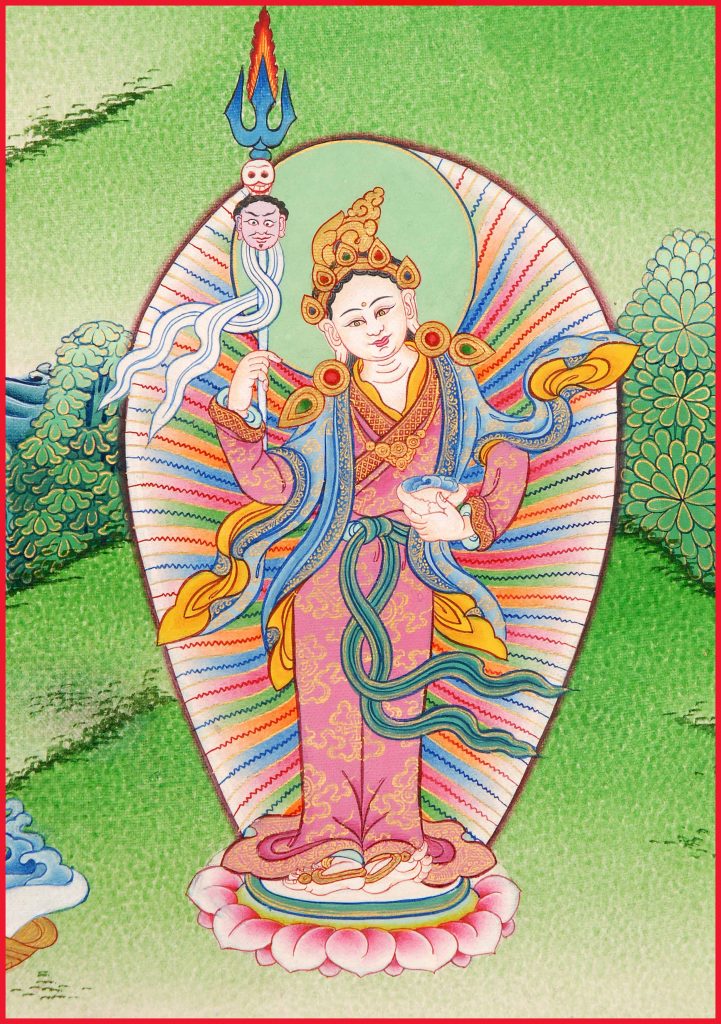
By then, however, most Bönpo priests had already gone into exile. Worried as to how to rectify all the bad signs that still plagued his kingdom, Trisong Deutsen consulted various diviners and oracles. They all advised the King to permit Drenpa Namkha to return to practising Yungdrung Bön openly and invite other Bönpo masters back to Tibet. Besides Drenpa Namkha himself, only one important Bönpo master remained in Central Tibet: Drenpa Namkha’s student and consort, Khandro Chöza Bönmo.[60] At Trisong Deutsen’s request, she traced Bönpo lamas and invited them back to Tibet. The King offered the Bönpos lands and titles, and asked them to perform rituals and build Bönpo chörten[61] (stupas) to pacify negativities and problems in the country. Thus, the situation gradually improved. Seeing this, Trisong Deutsen issued a decree whereby Yungdrung Bön and Indian Buddhism should be practised together. He told Bönpos:
“Bon and Buddhism have each been suppressed in turn in the past. But now, as I have called you back, I ask you to bring out textual treasures and to practise Bon and Buddhism together.”[62]
Two men were largely responsible for this. One was the renowned translator Pagor Bairotsana,[63] one of Guru Rinpoche’s most famous principal students, who had previously received a Bönpo education and went on to become one of Gyerpung Drenpa Namkha’s main disciples. The other was Drenpa Namkha himself, of course. Since both men were well-versed in both Buddhist and Bönpo traditions, they collected material from many different sources and composed an eclectic body of rituals combining the characteristics of Yungdrung Bön and Indian Buddhism. This was then presented to Trisong Deutsen. Despite his former enthusiasm, after some time, the King decided not to follow these new texts, and they were hidden in various places, to be rediscovered later, in around 14th century when they became known as New Bön.[64] This tradition is still very popular today, particularly in East Tibet.
Now, since Drenpa Namkha was permitted to return to his Yungdrung Bön faith openly, he continued to teach and comment on pure Yungdrung Bön. His students at this time were Pagor Bairotsana, the Bönpo yogini Chöza Bönmo and King Trisong Deutsen himself, who had undergone a change of heart and begun not only learning and practising Yungdrung Bön but also took an active part in preserving it from further destruction. At the Drag Yerpa[65] cave, a short distance East of Lhasa,[66] Gyerpung Drenpa Namkha taught these students the Dzogchen cycles of Yethri Thasel and Namkha Thruldzö. The group was also joined by Tsewang Rigdzin, who manifested visibly and received these teachings from this emanation of his father, Khöpung Drenpa Namkha. Tsewang Rigdzin later passed these Dzogchen teachings to Lungbön Lhanyen in the 11th century. They remain important study and practice manuals to this day.
Featured Image: Khöpung Drenpa Namkha statue, Triten Norbutse Bönpo Monstery, Kathmandu, Nepal. Photo by Dmitry Ermakov, 1996.
Bibliography
Drenpa Namkha, Yetri Thasel: Commentary Chapters regarding the Base of the Teachings that Elucidate One’s Wishes (and Needs), dGos ‘dod gsal byed bshad gzhai’i mchongs, Teachings by Yongdzin Lopön Tenzin Namdak Rinpoche, Pfauenhof, Germany, 8-14 September, 2007, Trnscr. & ed. Carol and Dmitry Ermakovi, (Blou: Shenten Dargye Ling, 2007).
_____. Yetri Thasel: dGos ‘dod gsal byed bshad gzhai’i mchongs, Commentary Chapters regarding the Base of the Teachings that Elucidate One’s Wishes (and Needs), CHAPTERS VIII & IX, Teachings by Yongdzin Lopön Tenzin Namdak Rinpoche, Pfauenhof, Germany, 6-12 September, 2008, Trnscr. & ed. Carol and Dmitry Ermakovi, (Blou: Shenten Dargye Ling, 2008).
Ermakov, Dmitry. Bѳ and Bön: Ancient Shamanic Traditions of Siberia and Tibet in their Relation to the Teachings of a Central Asian Buddha, (Kathmandu: Vajra Publications, 2008).
Karmay, Samten G. The Treasury of Good Sayings, (Delhi: Motilal Banarsidass Publishers Private Limited, 1972).
Kværne, Per. ‘A Chronological Table of the Bon po: The Bstan rcis of Ni rna bstan’ in Acta Orientalia, vol. 33 (1971), pp. 205–282.
Namdak, Yongdzin Lopön Tenzin, transl., transc. & ed. Nagru Geshe Gelek Jinpa, Ermakova, C. & Ermakov, D. The Heart Essence of the Khandro, Experiential Instructions on Bönpo Dzogchen: Thirty Signs and Meanings from Women Lineage-Holders, (New Delhi:Heritage Publishers, 2012).
_____. Namkha Truldzö, Teachings by Yongdzin Lopön Tenzin Namdak Rinpoche Vimoutiers, 3 –12 September 2004, Trnscr. & ed. Carol and Dmitry Ermakovi, (Blou, Shenten Dargye Ling, 2006).
_____. Namkha Truldzö: The Commentary on the Precious Oral transmission of
the Great perfection which is called the Treasury of Space, Shenten Dargye Ling, 2 – 21August 2005, Trnscr. & ed. Carol Ermakova and Dmitry Ermakov (Blou, Shenten Dargye Ling, 2006).
_____. Namkha Truldzö: The Commentary on the Precious Oral transmission of the Great Perfection which is called the Treasury of Space, Shenten Dargye Ling, 23 July – 11August 2006, Trnscr. & ed. Carol Ermakova and Dmitry Ermakov (Blou, Shenten Dargye Ling, 2006).
Norbu, Namkhai. Drung, Deu and Bön: Narrations, Symbolic language, and the Bön tradition in ancient Tibet, (Dharmasala: LTWA, 1995).
Sman-ri’i Mkhan-po Nyi-ma bstan-‘dzin, Sangs-rgyas-kyi bstan-rtsis mgo mtshar nor-bu’i phreng-ba.
Sman-ri’i Yongs-‘dzin Slob-dpon Sangs-rgyas bstan-‘dzin, Bla-chen dran-pa nam-mkha’i gsol-‘debs zhugs-so.
Sman-ri-ba Bstan-rnam, Tshe-dbang rig-‘dzin smon-lam.
Bla-ma Tshul-khrims phun-tshogs, Mkhar-dong gna’-shul ni lo-rgyus thog-gi zhang-zhung lte-ba’i-mkhar khyung-lung dngul-mkhar de-yin.
[1] Tib. Dran-pa nam-mkha’.
[2] Tib. grub-thob chen-po.
[3] Tib. Snyigs-ma’i mgon-po.
[4] Tib. bon-sku.
[5] Tib. Ston-pa Gshen-rab.
[6] Tib. Stag-gzig. Rtag-gzigs.
[7] Tib. Dag-pa dri-med.
[8] Tib. Rdzu-‘phrul ye-shes.
[9] Tib. ‘Ol-mo lung-ring.
[10] Tib. drang-srong.
[11] Tib. gdul-ba.
[12] Tib. Zhang-zhung.
[13] Tib. Khod-spungs Dran-pa nam-mkha’.
[14] Tib. gshen-po.
[15] Tib. Sman-ri’i Mkhan-po Nyi-ma bstan-‘dzin, Sangs-rgyas-kyi bstan-rtsis mgo mtshar nor-bu’i phreng-ba.
[16] Tib. Khyung-lung dngul-mkhar.
[17] Tib. Tib. Rgryung-yar mu-khod.
[18] Tib. Phya-btsun Gung-ma.
[19] Tib. Rgya-dkar, Rgya-zhang, Rtags,-gzigs, Thod-dkar (i.e. lands of Tokharians beyond the Northern border of Zhang Zhung in Central Asia), Bru-sha (Gligit).
[20] Tib. mkha’-‘gro.
[21] Tib. dur-khrod chen-po brgyad.
[22] Tib. U-rgyan.
[23] Tib. ‘Od-ldan ‘bar-ma.
[24] According to bstan-rtsis.
[25] Tib. gsang-sngags.
[26] Tib. rdzogs-chen.
[27] Tib. Gri-gum btsan-po.
[28] According to Bönpo Chronology. Chögyal Namkha Norbu places him in 1st century AD. Norbu, Namkhai. Drung, Deu and Bön: Narrations, Symbolic language, and the Bön tradition in ancient Tibet, (Dharmasala: LTWA, 1995), Introduction, p. xvi.
[29] Tib. ‘ja’-lus ‘pho-ba chen-po.
[30] Tib. Tshe-bang rig-‘dzin.
[31] Tib. Pad-ma mthong-grol.
[32] Tib. Tshe-dbang snyan-brgyud.
[33] Tib. Rig-‘dzin ‘dus-pa.
[34] Tib. bram-ze skye-ba bdun-pa.
[35] Tib. ye-shes kyi mkha’-‘gro.
[36] Sometimes referred to as Tib. ‘O-ma’i rgya-mtsho, Ocean of Milk.
[37] According to Bstan-rtsis.
[38] Tib. gter-ma.
[39] Tib. Skabs-brgyad.
[40] Tib. Snying-ma.
[41] Tib. Grub-pa bka’-brgyad.
[42] Tib. Rgya-nag.
[43] Tib. Me-nyag (aka Tangut, Xi Xia).
[44] Tib. Lung-bon lha-gnyan (b. 1088).
[45] Tib. Ye-khri mtha’-sel.
[46] Tib. Nam-mkha’ ‘phrul-mdzod.
[47] Tib. Gyer-spungs Dran-pa nam-mkha’.
[48] Tib. Khri-srong lde’u-btsan. Born 718 AD according to Bstan-rtsis. Professor Namkhai Norbu gives 742–797 AD as the dates for this king. See Norbu, Drung, Deu and Bön, Introduction, p. xvii.
[49] According to Drubdra Khenpo Tsultrim Tenzin (Tib. Sgrub-grwa mkhan-po Tshul-khrims bstan-‘dzin).
[50] Tib. Yul dag-po khog.
[51] Tib. Dmu-gshen Dag pa. I.e. Drenpa Namkha was born into the Mushen clan, the blood line of Tönpa Shenrab Miwo, whose descendants still live in Tibet today.
[52] Tib. Dag-za Mkha’-lcam.
[53] I.e. drink an excessive amount of water until one’s kidneys explode.
[54] Karmay, Samten G. The Treasury of Good Sayings (Delhi: Motilal Banarsidass Publishers Private Limited, 1972), p. 90.
[55] According to Bstan-rtsis. Samten Karmay argues that this happened in 784 AD (Karmay, The Treasury of Good Sayings, p. 94, note 2.
[56] Tib. Lig-mir-rgya.
[57] Tib. Gyer-spungs Snang-bzher lod-po.
[58] Tib. dzwo.
[59] Tib. Ma-mchog Srid-pa’i rgyal mo.
[60] Tib. Mkha’-‘gro Co-za bon-mo.
[61] Tib. mchod-rten.
[62] Ibid. p. 101.
[63] Tib. Ba-gor Bai-ro-tsa-na.
[64] Tib. bon gsar ma.
[65] Tib. Brag yer-pa.
[66] Tib. Lha-sa.
